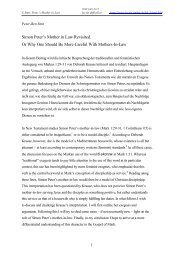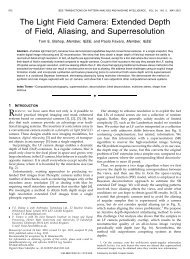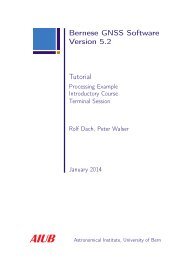Minimal Models of Adapted Neuronal Response to In Vivo–Like ...
Minimal Models of Adapted Neuronal Response to In Vivo–Like ...
Minimal Models of Adapted Neuronal Response to In Vivo–Like ...
Create successful ePaper yourself
Turn your PDF publications into a flip-book with our unique Google optimized e-Paper software.
Adapting Rate <strong>Models</strong> 2113<br />
Table 1: Summary <strong>of</strong> the Results <strong>of</strong> the Fit <strong>of</strong> the LIF Neuron <strong>to</strong> the Experimental<br />
Rate Functions <strong>of</strong> 26 Rat Neocortical Pyramidal Cells.<br />
AHP<br />
AT<br />
N 14 13<br />
α [pA · s], β [mV · s] 4.3 ± 2.2 0.29 ± 0.13<br />
τ r [ms] 9.0 ± 6.5 3.0 ± 4.0<br />
τ [ms] 33.2 ± 9.4 32.5 ± 9.2<br />
C [nF] 0.50 ± 0.18 0.50 ± 0.18<br />
V r [mV] 0.1 ± 11.2 1.1 ± 13.7<br />
P 0.40 ± 0.30 0.33 ± 0.29<br />
Notes: N is the number <strong>of</strong> fitted cells that required an<br />
adaptation parameter (α, orβ) > 0. Two cells could<br />
be fitted without adaptation and were not included<br />
in the analysis. The parameters (left-most column)<br />
are defined in section 2.1 and their best-fit values are<br />
reported as average ± SD. The threshold for spike<br />
emission was held fixed <strong>to</strong> 20 mV. P is the probability<br />
P[χ 2 >χmin 2 ] across fitted cells requiring adaptation.<br />
A fit was accepted whenever P > 0.01. The threshold<br />
for spike emission was held fixed <strong>to</strong> 20 mV. AT:<br />
adapting threshold model.<br />
The population activity <strong>of</strong> noninteracting neurons is well predicted by<br />
f (t) = (m x , s 2 x ), where is the stationary response function, and m x, s 2 x<br />
are the time-varying average and variance <strong>of</strong> I x (see, e.g., Renart, Brunel, &<br />
Wang, 2003). These evolve according <strong>to</strong> the first-order dynamics (ẏ ≡ dy/dt),<br />
τ x ṁ x =−(m x − ¯m x ), (3.2)<br />
and analogously for s 2 x , with τ x replaced by τ x /2 (e.g., Gardiner, 1985). We<br />
now include adaptation in the following way:<br />
f = (m x − I ahp , s 2 x )<br />
τ N İ ahp =−I ahp + αf, (3.3)<br />
where I ahp is the AHP current, which follows the instantaneous output rate<br />
with time constant τ N . Note that for a stationary stimulus, that is, ν x constant,<br />
after a transient <strong>of</strong> the order <strong>of</strong> max{τ x ,τ N }, one recovers the stationary<br />
model, equation 2.2, with m = ¯m x , s = ¯s x .<br />
<strong>In</strong> the case <strong>of</strong> several independent components, they follow their own<br />
synaptic dynamics and sum up in the argument <strong>of</strong> the response function <strong>to</strong><br />
give the time-varying firing rate:<br />
( ∑<br />
f = m x − I ahp , ∑ )<br />
s 2 x .<br />
x<br />
x
















